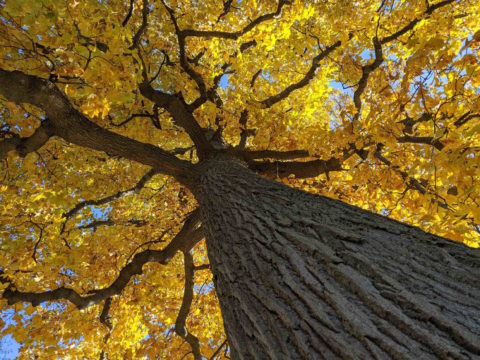
BY MARGARET LAPP, SOUTH PARK ARBORETUM CURATOR
Welcome to the inaugural edition of Arboretum Musings, a quarterly newsletter devoted to the South Park Arboretum restoration. Trained as a landscape architect and public health professional, with a penchant for plants, I am thrilled to be leading the 11-phase restoration project, as South Park Arboretum’s Curator.

1894 General Plan of South Park overlaid with 2016 aerial photo
Introduction | 126 Years in the Making…
I earnestly invite you to journey with me through time, reflecting on Buffalo’s past while looking to the future of the Queen City, as this restoration breathes new life into the Arboretum at South Park. One hundred and twenty-six years in the making, South Park has undergone a century of change and despite deferred maintenance, the Arboretum has the potential to be restored to Olmsted’s original vision, including his ambitious goals for the plant collection. Returning the Arboretum to its original world-class glory is monumental for the Western New York (WNY) region given the many benefits an arboretum brings.
Arboreta (trees) are considered the focal points of the communities in which they are nestled. South Park Arboretum has infinite potential, and serves as a community, cultural, and public health asset to the WNY region and beyond.
Community Asset

Frederick Law Olmsted, Sr.
Frederick Law Olmsted was not only the father of landscape architecture but also a visionary and champion of parks being for all people. Olmsted’s “design for the masses” mantra espoused a radical viewpoint for his time. The purpose, the heart and soul, of an arboretum is to save, understand and interpret woody plants. Conservation of trees is crucial for ecosystem vitality. Living plant collections are essential to the fabric of a community, they visibly provide diversity in their leaf and bark texture, height, size and fall color. Arboreta support wildlife as over one hundred U.S. vertebrate species, such as blue jays and squirrels, rely on acorns, and other nuts and fruits for sustenance. The many qualities of an arboretum support the future welfare of our planet, namely safeguarding biodiversity; continuously growing and changing in a dynamic relationship with the environment, plants are more than a static part of a collection, rather, evolving elements of the greater ecosystem. All of this contributes to a vibrant and cohesive community and natural environment which everyone has access to and benefits from.

South Park, with the Buffalo & Erie County Botanical Gardens in the background
Cultural Asset
South Park upholds its standing as a prominent cultural landscape, over a century after it first opened to the public in 1899, as it represents a work of art. South Park Arboretum is one of just two arboreta (the second being Arnold Arboretum at Harvard in Boston, Massachusetts) designed by Olmsted.
It was built in keeping with his original plans, and the sheer significance of this cultural landscape is unparalleled. A prominent cultural institution of its own right, the arboretum serves the WNY community as a living museum of trees; a place to learn and engage. According to a 1925 description on ethics by the American Association of Museums, “Museums, in the broadest sense, are institutions which hold their possessions in trust for humankind and for the future welfare of the [human] race.” In tandem with the Buffalo and Erie County Botanical Gardens built and located within South Park, the South Park Arboretum serves as a significant cultural treasure and destination for the WNY region and beyond.
Public Health Asset

Tulip Poplar Tree, Liriodendron tulipifera
Olmsted’s visionary planning and design for South Park and its Arboretum opened the door to improving health and wellbeing and continues to positively affect park visitors today. Safe access to green space, such as parks, contributes to positive health outcomes including overall health status and life expectancy. Trees breathe life into us all, generating and supporting our air quality. The COVID-19 pandemic has poignantly reminded us how precious parks and access to green space are for our community and our health.
Spending time in nature reduces stress and cortisol levels and boosts the immune system. Just a few minutes of sunlight exposure, alone, can help lower high blood pressure and risk of heart disease. The pandemic has changed the dialogue concerning the essential value of parks. Buffalo Olmsted Parks Conservancy (BOPC) has seen a 40% increase in park usage since 2020. The pandemic has connected us to Olmsted in an unfathomable way, despite the century separating us in time, as Olmsted and his firm designed with remarkable foresight and commitment to the sustained health and wellbeing of multi-generations of Buffalonians. Aren’t we fortunate?
Parting Thoughts
More than 100 years after Olmsted’s vision for South Park and its Arboretum was brought to life, his democratic ideals concerning access to green space have powerfully transcended time. South Park Arboretum offers not only a home to hundreds of tree species, moreover a beautiful respite from the hustle and bustle of our busy lives, as Olmsted originally intended. South Park Arboretum is a necessary community, cultural and public health asset that continues to infuse life into the WNY region. Join me in exploring the development of this living museum and plant collection, and reinvigorating Olmsted’s original 1892 planting plan, complete with over fifty plant families, in our next edition of Arboretum Musings.





